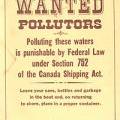 In 1976, I got my first full-time summer job as a member of the Memphremagog Conservation Patrol. I was sixteen years old. I had worked on the patrol as a volunteer for a few days during the two preceding summers, making $5.00 a day the first year and $7.00 the second. As a full-time patrol member, I made $75.00 a week, including a one-week paid vacation which I spent at the Olympics in Montreal.
In 1976, I got my first full-time summer job as a member of the Memphremagog Conservation Patrol. I was sixteen years old. I had worked on the patrol as a volunteer for a few days during the two preceding summers, making $5.00 a day the first year and $7.00 the second. As a full-time patrol member, I made $75.00 a week, including a one-week paid vacation which I spent at the Olympics in Montreal.
There were three other full-time patrol members that summer: Ken Mitchell, who was the team leader, Jeff Losch, and Sharon Baillie. Sharon lived on Channel Bay, I was in Cedarville, Jeff was near Owl’s Head, and Ken was at Quinn Bay near Georgeville. There was also a part-time patroller, Jumper Vass, who lived on Sargent’s Bay, and a number of volunteers. Sharon Baillie and I were five days apart in age and became lifelong friends, keeping in touch intermittently over the years until she died in 2007. She never lost her love of the lake.
 Getting hired as a full-time patrol member wasn’t easy. Applicants were given a thick packet of lake-related scientific research to study, including information on various kinds of septic systems. I can still remember reading about a chemical device called the Destroy-let. We then had to take an exam, which we wrote in a lab at McGill. Unbelievably, I got the job.
Getting hired as a full-time patrol member wasn’t easy. Applicants were given a thick packet of lake-related scientific research to study, including information on various kinds of septic systems. I can still remember reading about a chemical device called the Destroy-let. We then had to take an exam, which we wrote in a lab at McGill. Unbelievably, I got the job.
Patrol members occasionally took water samples to send off for laboratory testing, but for the most part, the job did not require much in the way of scientific or technical expertise, despite the reading we had done in preparation for the exam. Mostly what we did was travel around the lake collecting boatloads (literally) of garbage. The patrol worked with two small, open, leaky aluminum boats, using green plastic garbage bags as raincoats in rough and wet weather. I remember a particularly harrowing ride to work one morning when I had to make my way alone from Cedarville to Quinn Bay in waves that were several feet high.
One of our main duties was to maintain big green and yellow garbage barrels with the MCI logo stuck on them that were located at various popular spots around the lake. We emptied the barrels every Monday, loading the boats with precariously balanced mountains of garbage that had accumulated over the course of the preceding week. One very hot Monday morning, as I was emptying a garbage barrel at a public campground, a passing camper said to me, “Mmm, those steaks were good!” She was referring to the remains of the weekend’s barbeque that were rotting in the bag, which later got punctured and leaked maggots into the water at our feet as we made our rounds in our leaky boat. This may not sound like much fun, but it actually was a really great summer.
 Another major duty was “shore patrol,” which entailed slowly patrolling every inch of the lake’s shoreline and traveling as far up its connecting rivers as we could go, picking up any garbage that was visible on the shore and in the shallow water and loading it into the boats. We found lots of the usual type of litter, including large numbers of empty bottles which we saved to fund our end-of-summer party, but we sometimes found more interesting items. I remember a large dead turtle on the shore near Prouty Beach, and Sharon found a set of false teeth that she kept for a while and used as an ashtray. We also visited every house on the lake, selling MCI stickers, recruiting members, and distributing informational materials, such as a “Wanted: Polluters” flyer done in Wild West style.
Another major duty was “shore patrol,” which entailed slowly patrolling every inch of the lake’s shoreline and traveling as far up its connecting rivers as we could go, picking up any garbage that was visible on the shore and in the shallow water and loading it into the boats. We found lots of the usual type of litter, including large numbers of empty bottles which we saved to fund our end-of-summer party, but we sometimes found more interesting items. I remember a large dead turtle on the shore near Prouty Beach, and Sharon found a set of false teeth that she kept for a while and used as an ashtray. We also visited every house on the lake, selling MCI stickers, recruiting members, and distributing informational materials, such as a “Wanted: Polluters” flyer done in Wild West style.
The shores of the lake look much cleaner now than they did in my days on the Memphremagog Conservation Patrol, but there are many more – and much larger – houses on it, which in turn mean fewer trees and more noise and light pollution, and there are environmental threats that we didn’t know much about in 1976. We never thought about blue algae or zebra mussels, for example, and last summer, I noticed purple loosestrife – sold in large inexpensive pots at Costco in Sherbrooke – deliberately planted in flower beds at some of the new houses near the Cedarville wharf.
A couple of years ago, I was walking my dog in the Calgary neighborhood where I now live, when, to my amazement, I spotted a young man getting into a car with the familiar MCI logo on its bumper. It turned out that his parents had just bought a cottage near Georgeville and had given him the sticker when he was there for a visit. However much things may have changed since 1976, it’s great to know that MCI is still out there recruiting members, raising money and awareness, and keeping a watchful eye on the “beautiful waters” of Lake Memphremagog.
*Penny Farfan grew up in St. Lambert, Quebec, and spent her summers at the family cottage on Lake Memphremagog. She currently lives in Calgary, Alberta.